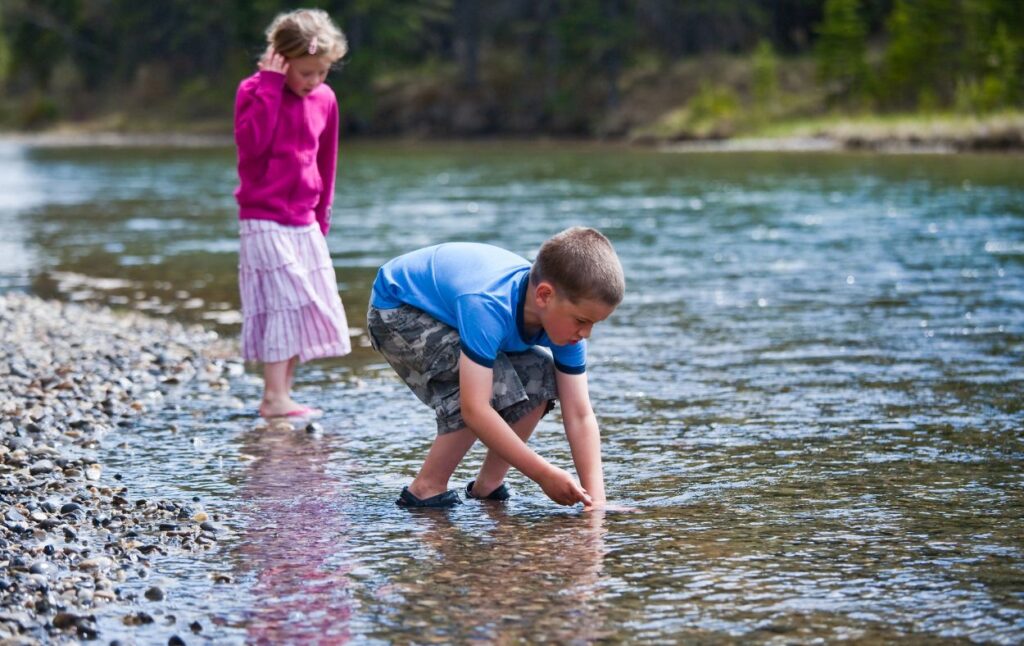Water Play for Kids of ALL Ages!
How do you spend time outside when it’s hot? WATER! Pretty much anything we do as a family outside in the summer has to do with water. It keeps kids cool, it’s super fun, it provides sensory exploration, and it’s SO SIMPLE. Let’s explore easy and simple water play ideas for kids of all ages!

Why is water play important?
Check out these compelling reasons why it’s important to let your kids play with water for their holistic development!
- Sensory Stimulation: Water play stimulates the senses, providing children with opportunities to explore different textures, temperatures, and sounds. This sensory input enhances neural connections in the brain, fostering cognitive development.
- Fine Motor Skills: Pouring, squeezing, and splashing water help develop hand-eye coordination and fine motor skills. Activities like scooping and pouring water into containers refine children’s grasp and manipulation abilities.
- Scientific Exploration: Water play introduces kids to basic scientific concepts such as buoyancy, density, and volume. Through experimentation, they learn about cause and effect, observation, and hypothesis testing in a hands-on environment.
- Social Interaction: Water play encourages socialization and cooperation among children. Whether they’re working together to build a sandcastle or engaging in a water balloon fight, these activities promote teamwork and communication skills.
- Emotional Regulation: Water play offers a calming effect, aiding in emotional regulation and stress relief. The soothing nature of water can help children unwind and manage their emotions effectively.
Where should I play with water?
While I love a good pool day or splash pad, we end up playing with water in our driveway most summer days. I fill up some buckets, add soap or food coloring to be fancy, and BAM, Water MAGIC! We have a large assortment of random plastic buckets and containers laying around so my kids spend most of the time scooping, pouring, and carrying (hello heavy work). You don’t need to put a lot of effort into this (woohoo!). Use plastic containers from around your house, old measuring cups, random kitchen utensils, sponges, scrub brushes, and plastic cups from fast food restaurants. The kids have full access to dirt, leaves, flowers, rocks, and whatever else they can find in our yard. I encourage them to use things that have already fallen on the ground instead of picking leaves and flowers from bushes and trees. That teaches them to be aware of their environment and be “Leave No Trace” conscious.
It really doesn’t take a whole lot of prep to get kids to play with water which is one of the BEST things about it. Some days I let the kids use the hose to wash the cars and outdoor toys or turn the sprinkler on for them to run through, but I am a big believer in kids using their imagination and playing independently. We practice water safety rules and I make sure that all kids are supervised appropriately around water. Drowning is the number one cause of child deaths and that can happen in all different depths of water (including buckets). I grew up in the desert where everyone had a pool so this was drilled into my head as a child and still resonates with me frequently. Practice appropriate water safety and have FUN! Grab sunscreen, a lawn chair, and an ice cold drink and enjoy the sun! Bonus, it keeps your house clean!
Backyard Water Play Ideas for Different Age Groups:
Toddlers (Ages 2-4):
- Sensory Bins: Fill a shallow container with water and add toys like rubber ducks, sponges, and measuring cups. Let toddlers explore the textures and splash around in the water.
- Water Tables: Invest in a water table designed for toddlers, featuring built-in accessories like water wheels, funnels, and scoops. These tables provide endless entertainment and sensory stimulation. I got ours at Aldi! You can also buy a pump online that keeps the water running so you don’t have to! This is great for reducing water use!
- Bubble Play: Blow bubbles for toddlers to chase and pop. Alternatively, provide them with bubble wands and encourage them to create their own bubble masterpieces. Teaching kids to blow bubbles helps them develop a new skill and can increase their concentration and provide them with an appropriate coping strategy for anger.

Preschoolers (Ages 4-6):
- Outdoor Water Obstacle Course: Set up a backyard obstacle course with sprinklers, inflatable pools, and water tunnels. Challenge preschoolers to navigate through the course while staying cool and having fun. This is SO FUN!
- Ice Excavation: Freeze small toys or objects in ice cubes and let preschoolers use water syringes or spray bottles to melt the ice and excavate the treasures hidden within.
- Sink or Float Experiment: Fill a basin with water and gather various objects from around the house or in your yard. Have preschoolers predict whether each item will sink or float before testing their hypotheses. Don’t forget, this website is all about simplicity so make them go gather the toys 🙂

School-Age Kids (Ages 7-12):
- Water Balloon Games: Organize water balloon tosses, relays, or target practice games for older children. Water balloons add an element of excitement and competition to outdoor play. Turn cleaning the pieces up into a game (find the *magic* piece, and get a treat!). If they are going to make the mess, they better clean it up!
- Obstacle courses are especially fun in the summer and kids can develop them by themselves!
- DIY Water Rockets: Challenge kids to design and build their own water rockets using plastic bottles, cardboard fins, and duct tape. Launching these rockets provides a hands-on lesson in physics and aerodynamics.
- Underwater Science Experiments: Fill a large container with water and conduct simple science experiments such as dissolving salt, observing buoyancy with different objects, or exploring water pressure using syringes and tubes.

Sensory benefits of water play
We know that water provides sensory play, but why is that important? What is the science behind water play? Let’s delve into the sensory benefits of water play, supported by research, and discover why it’s a must-have activity for children of all ages.
1. Tactile Sensation:
The tactile sensation of water is one of the most captivating aspects of water play. Whether it’s the cool touch of a stream or the squishiness of wet sand, water stimulates the sense of touch in a unique and profound way. Research has shown that tactile experiences, such as those provided by water play, play a crucial role in children’s sensory development. According to a study published in the Journal of Pediatric Nursing, tactile stimulation through water play can enhance sensory integration and contribute to improved motor skills in children with sensory processing difficulties.
2. Visual Stimulation:
Water captivates us with its shimmering surfaces, swirling patterns, and intriguing reflections. As children watch water flow, splash, and change shape, they engage in visual tracking and perception exercises that promote visual-motor coordination and spatial awareness. A study conducted by researchers at the University of Pittsburgh found that exposure to visually stimulating environments, such as those created by water play, can enhance visual processing abilities and contribute to overall cognitive development in children. Water, like fire, is one of those natural phenomenon that captivates our attention even as adults. It’s a great way to engage kids in outdoor play!
3. Auditory Engagement:
The sound of water flowing is scientifically proven to reduce stress. It’s relaxing, calming, and a great way to engage other parts of the brain while kids play outside!
4. Proprioceptive Feedback:
Water play provides valuable proprioceptive feedback, as children exert force and pressure while manipulating water and objects within it. This feedback helps children develop body awareness and spatial perception, enhancing their proprioceptive sense—the ability to perceive and understand the position and movement of their bodies in space. Activities involving proprioceptive input, such as water play, can improve children’s motor planning and coordination skills. Proprioception is a skill that many kids lack in the age of screens because they are not getting enough practice using it through outdoor play. Check out the book, Balanced and Barefoot, to learn more.
5. Vestibular Stimulation:
Water play often involves dynamic movements such as splashing, jumping, and wading, which provide rich vestibular stimulation—the sense of balance and spatial orientation. This stimulation helps children develop a strong vestibular system, which is essential for maintaining postural control, coordination, and equilibrium.

Natural water play activities
While we have mainly discussed at-home or created water experiences in this article, I highly encourage you to find a natural water source (creek, dam, waterfall, pond) nearby and spend a day exploring it. Use the opportunity to ask good questions, get to know your kids, show them activities that you enjoy (or are learning to), and work on that family culture! Happy Adventuring!
Check out other outside play ideas for kids!
- The 1000 Hours Outside Challenge
- 15 tips for Hiking with Kids
- How to Become an Adventure Mom
- The BEST chalk games!
This article was written by Emily Fedel and inspired by AI.
Follow me on Instagram!




